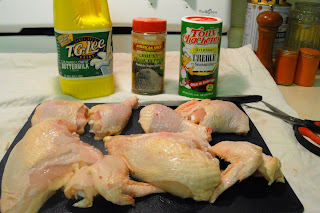
When I die and go to heaven, I'm going to have a Sub-Zero refrigerator and a Viking gas stove.
I have a confession to make. I hate my kitchen.
Under no circumstances will I ever buy another smooth surface electric range. The front right burner has two settings that work - el scorcho and not hot enough. The white porcelain has darkened over the burners and, no matter how hard I try, they never look clean any more.
The oven is fickle and runs sometimes too hot, and sometimes not, which makes baking somewhat of an adventure.
My refrigerator never seems to have enough room.
The sinkhole is making the kitchen floors wavy and my cabinet doors gape annoyingly open.
I try to look at things from the perspective of the lyrics of a Sheryl Crow song:
"It isn't having what you want, it's wanting what you've got."
But I can dream.
What does any of this have to do with the recipe?
Well, not much.
I've been watching cooking shows on TV for a very long time and I'm starting to become a little disappointed in the offerings on the Food Network.
In my opinion, the shows seem to be less about food and more about personalities and selling cookware or knicknacks - like Semi-Homemade - or create dishes using equipment and ingredients no home cook realistically has access to - like Iron Chef. (When was the last time you saw squab or sea urchin at the grocery store?)
The other day we were flipping through the channels and came across an old Julia Child series on PBS.
Julia was all about the food and never seemed to rely on fancy gagets or equipment. She created her masterpeices with quality ingredients, a serviceable stove, a few good pots, pans and knives and a copper bowl and a whisk.

Tourte Milanese adapted from the PBS series In the Kitchen with Julia - Episode: Puff pastry with Michel RichardIngredients:1 pound puff pastry
1 tablespoon olive oil
1 tablespoon butter
1 pound fresh spinach (blanched, chopped, and drained very well)
2 cloves garlic, minced
½ teaspoon freshly grated nutmeg
salt and ground black pepper, to taste
2 large roasted red bell peppers
8 extra large eggs
2 teaspoons chopped chives
2 teaspoons chopped flat leaf parsley
1 teaspoon chopped fresh tarragon
salt, to taste
2 tablespoons butter
½ pound thinly sliced Swiss cheese
½ pound thinly sliced ham
soft butter to grease pan
1 beaten egg for egg wash
Directions:Grease an 8-inch spring form pan with soft butter. Roll out ¾ of the puff pastry ¼ inch thick and line bottom and sides of pan leaving a 1-inch overhang. Roll out the remaining pastry into ¼ inch thick and cut out 8-inch circle. Transfer into a plate. Keep both pastries refrigerated while preparing the filling.
To roast peppers: If you have a gas stove, turn one burner on low to medium and place pepper directly on the flame to char the outside skin and soften the pepper. Keep turning the pepper until all sides are charred. Put the peppers in a paper or plastic bag to steam then peel the charred skin from the pepper and remove the stem and seeds.
The peppers can be roasted the same way on an outdoor gas or charcoal grill or in an electric oven set to broil.
Heat oil and butter in a large skillet. Add spinach and garlic and saute for 2 minutes. Season to taste with salt, pepper, and nutmeg. Remove from heat, set aside.
To make the omelets, whisk four eggs in a bowl then add half of the herbs and salt to taste. Melt 1 tablespoon of butter in an 8-inch skillet over medium heat, coating the bottom of skillet evenly. Pour the egg mixture and stir briefly. As eggs start to set, lift edges
so liquid can run under. When eggs are completely set but still moist, transfer omelet onto a plate. Repeat with the remaining eggs and herbs.
Remove the lined pan from the refrigerator.
Layer ingredients in following order: 1 omelet, half of the spinach, half of cheese, half of ham, all of the red bell peppers. Repeat layering in reverse order using the remaining ingredients.
Remove the 8-inch pastry from refrigerator and place over omelet. Seal well to pastry lining by pinching together with fingers. With tip of knife, draw desired number of slices directly on the pastry. Make a small hole in the center of the pastry. Brush all over with beaten egg. Refrigerate for 30 minutes.
Position rack in lower third of oven, preheat to 350 degrees F.
Brush pastry one more time with beaten egg. Place pan on a baking sheet and bake until golden brown, about 1 ½ hours. Cool for 30 minutes, release from pan. Slice and serve warm.
A couple of tips on using frozen puff pastry:
Don't let the pastry get too warm when you thaw it or you will have a hard time getting the packaging off and rolling it out.
If you don't let it thaw enough, it will crack when you unroll it.








